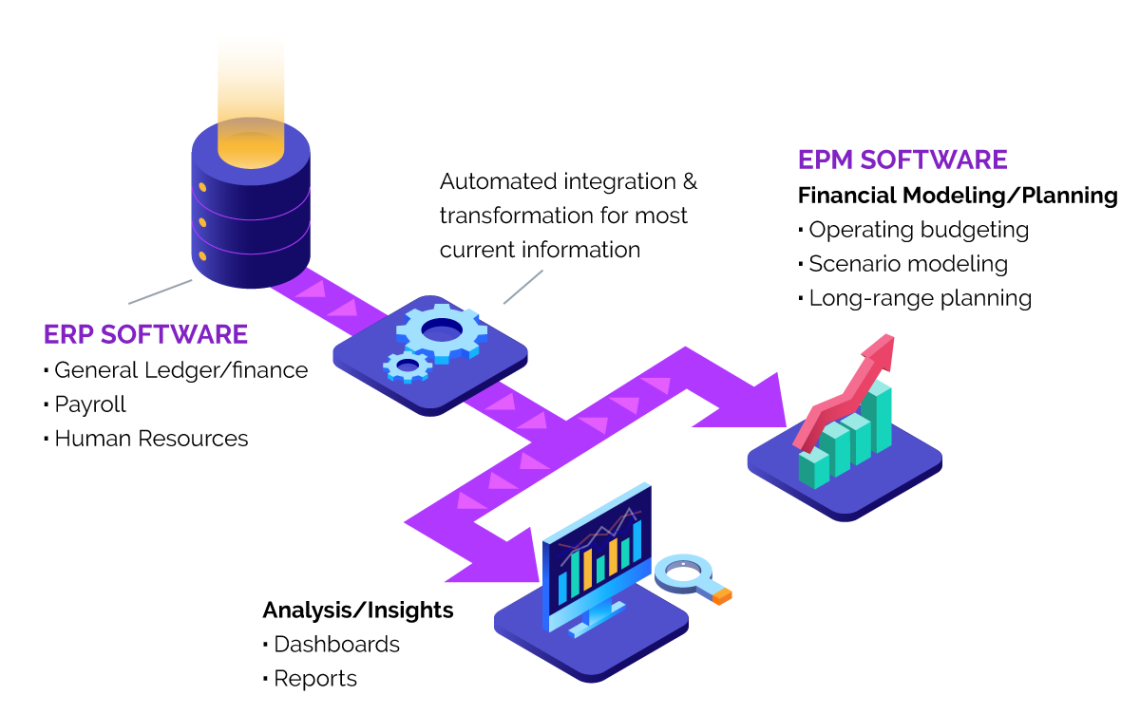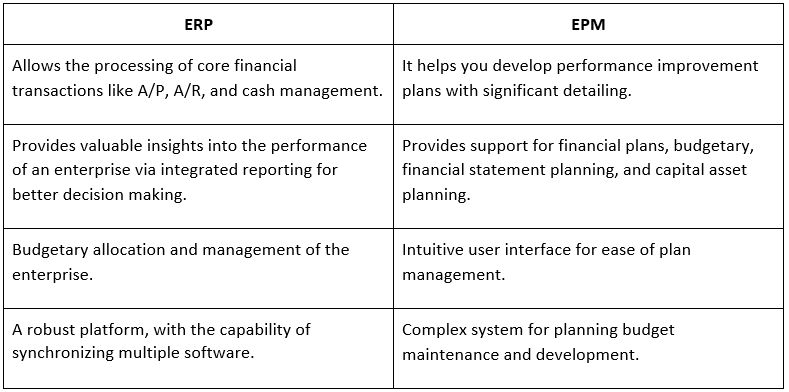ERP vs EPM: A Comprehensive Guide to Unlocking Business Value
Introduction
In today’s rapidly evolving business landscape, organizations are constantly seeking ways to streamline operations, enhance decision-making, and gain a competitive edge. Enterprise Resource Planning (ERP) and Enterprise Performance Management (EPM) systems have emerged as powerful tools that can empower businesses to achieve these goals. However, understanding the distinctions between these two solutions is crucial for making an informed decision that aligns with your organization’s specific needs.
ERP vs EPM: A Comparative Overview
ERP: A Backbone for Integrated Business Processes

ERP systems are comprehensive software suites that integrate various business functions, including finance, supply chain management, manufacturing, human resources, and customer relationship management. By centralizing data and automating processes across these departments, ERP solutions provide a single source of truth, enhance collaboration, and improve operational efficiency.
EPM: Empowering Performance Measurement and Analysis
EPM systems are designed to enhance financial and operational performance by providing organizations with a comprehensive view of their business. These solutions enable businesses to set targets, track progress, and identify areas for improvement. By integrating data from multiple sources, EPM systems empower decision-makers with real-time insights to make informed decisions and drive better outcomes.
Key Pain Points of Ideal Customer Personas
Challenges Faced by ERP Implementers
- Data Integration Hurdles: Integrating data from disparate systems can be a complex and time-consuming process.
- Customization Complexity: ERP systems are often highly customizable, which can lead to challenges in tailoring the solution to specific business needs.
- Implementation Costs: ERP implementations can be expensive, requiring significant upfront investments.
Challenges Faced by EPM Users
- Data Accuracy Concerns: Ensuring the accuracy and reliability of data used in EPM systems is critical for effective performance management.
- Lack of User Adoption: Resistance to change and inadequate user training can hinder the adoption and utilization of EPM systems.
- Limited Integration Capabilities: Some EPM systems may not seamlessly integrate with existing ERP or other business applications.

Advantages and Disadvantages of ERP vs EPM
Benefits of ERP Systems
- Improved Operational Efficiency: ERP systems automate tasks, reduce manual errors, and streamline processes, leading to increased productivity.
- Enhanced Data Integrity: Centralized data storage ensures data accuracy and consistency across the organization.
- Better Decision-Making: Real-time access to data empowers decision-makers with insights to make informed decisions.
- Increased Collaboration: ERP systems foster collaboration by providing a common platform for different departments to share information and coordinate efforts.
- Improved Customer Service: Integration with CRM modules enables businesses to better understand customer needs and provide personalized experiences.

Benefits of EPM Systems
- Enhanced Financial Management: EPM systems provide a comprehensive view of financial performance, enabling better budgeting, forecasting, and risk management.
- Improved Operational Performance: By tracking key performance indicators (KPIs), EPM systems help businesses identify areas for improvement and optimize operations.
- Increased Agility: Real-time insights empower organizations to respond quickly to changing market conditions and make data-driven decisions.
- Improved Compliance: EPM systems can help businesses comply with regulatory requirements and industry best practices.
- Enhanced Stakeholder Reporting: EPM systems generate reports and dashboards that provide stakeholders with a clear understanding of the organization’s performance.
Drawbacks of ERP Systems
- High Implementation Costs: ERP implementations can be expensive and require significant upfront investments.
- Complexity and Customization Challenges: ERP systems are complex and require careful customization to meet specific business needs, which can be time-consuming and costly.
- Potential Data Overload: ERP systems can generate vast amounts of data, which can be overwhelming for users and make it difficult to extract meaningful insights.
Drawbacks of EPM Systems
- Data Accuracy Concerns: The effectiveness of EPM systems relies heavily on the accuracy and reliability of the underlying data.
- Limited Integration Capabilities: Some EPM systems may not seamlessly integrate with existing ERP or other business applications.
- User Adoption Challenges: Resistance to change and inadequate user training can hinder the adoption and utilization of EPM systems.
ERP vs EPM: Which Solution is Right for You?
The choice between ERP and EPM systems depends on the specific needs and priorities of your organization. If your primary focus is on integrating business processes and improving operational efficiency, an ERP system may be the ideal solution. On the other hand, if your organization is seeking to enhance financial and operational performance through data analysis and reporting, an EPM system may be more suitable.
Summary of ERP vs EPM
| Feature | ERP | EPM |
|---|---|---|
| Primary Focus | Business Process Integration | Performance Measurement and Analysis |
| Key Benefits | Improved Operational Efficiency, Enhanced Data Integrity, Better Decision-Making | Enhanced Financial Management, Improved Operational Performance, Increased Agility |
| Drawbacks | High Implementation Costs, Complexity and Customization Challenges, Potential Data Overload | Data Accuracy Concerns, Limited Integration Capabilities, User Adoption Challenges |
| Ideal Use Cases | Organizations seeking to streamline operations and improve collaboration | Organizations seeking to enhance financial and operational performance through data analysis and reporting |
Q&A
1. What is the difference between ERP and EPM systems?
ERP systems focus on integrating business processes, while EPM systems prioritize performance measurement and analysis.
2. Which solution is better for my organization?
The choice depends on your specific needs. ERP is ideal for process integration, while EPM is suitable for performance management.
3. What are the advantages of ERP systems?
ERP systems improve operational efficiency, enhance data integrity, and support better decision-making.
4. What are the disadvantages of ERP systems?
ERP systems can be expensive to implement, complex to customize, and may lead to data overload.
5. What are the advantages of EPM systems?
EPM systems enhance financial management, improve operational performance, and increase agility.
6. What are the disadvantages of EPM systems?
EPM systems may face data accuracy concerns, limited integration capabilities, and user adoption challenges.
7. How do I choose between ERP and EPM systems?
Consider your organization’s specific needs and priorities to make an informed decision.
8. What is the implementation process for ERP systems?
ERP implementation involves planning, data migration, customization, testing, and deployment.
9. What is the implementation process for EPM systems?
EPM implementation involves data integration, configuration, user training, and ongoing maintenance.
10. What are the best practices for ERP implementation?
Best practices include thorough planning, data quality management, user involvement, and vendor support.
11. What are the best practices for EPM implementation?
Best practices include data accuracy verification, user adoption strategies, and ongoing performance monitoring.
12. How can I maximize the value of my ERP system?
Maximize value through user training, data quality management, and continuous process improvement.
13. How can I maximize the value of my EPM system?
Maximize value through data accuracy maintenance, user adoption, and regular performance analysis.
Conclusion
ERP and EPM systems are powerful tools that can transform business operations and drive performance improvement. By understanding the distinctions between these solutions and carefully evaluating your organization’s needs, you can make an informed decision that will empower your business to achieve its full potential. Remember, the key to success lies in embracing these technologies and leveraging their capabilities to drive innovation, efficiency, and growth.
Closing Statement
The choice between ERP and EPM is not a simple one, but it is an essential one for organizations seeking to gain a competitive edge in today’s dynamic business environment. By weighing the advantages and disadvantages of each solution and carefully considering your organization’s unique requirements, you can make an informed decision that will propel your business towards success. Embrace the power of these technologies and unlock the full potential of your organization.
